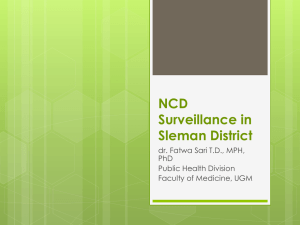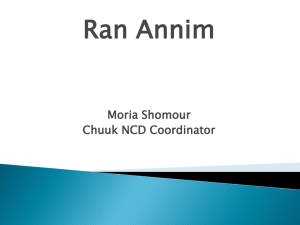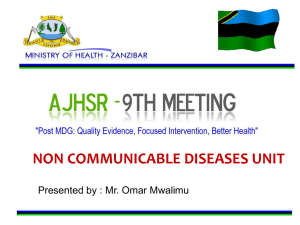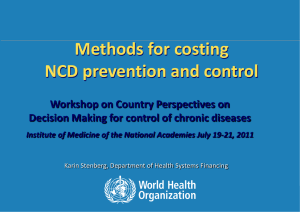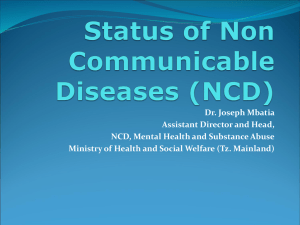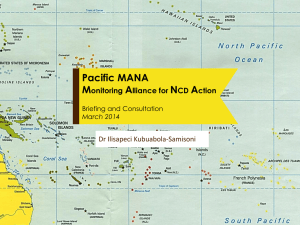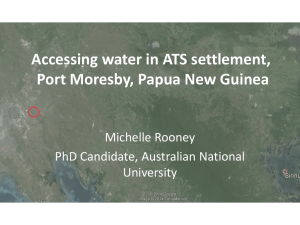Presented
advertisement
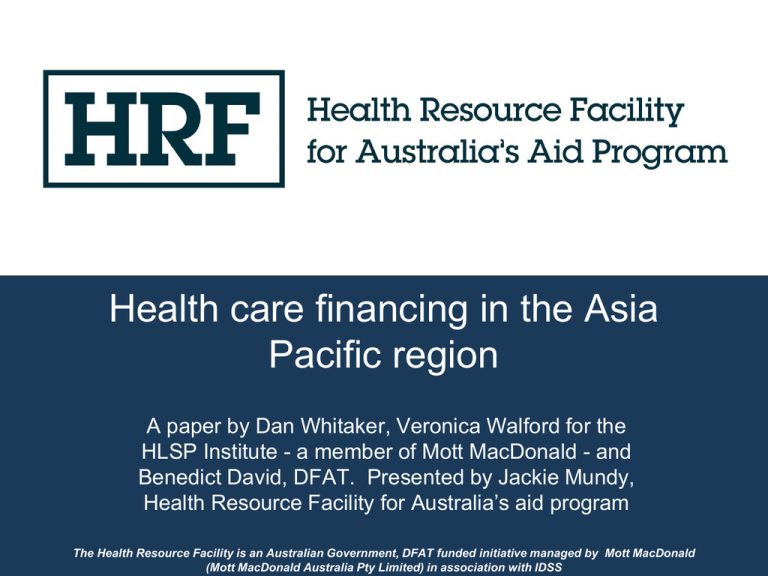
Health care financing in the Asia Pacific region A paper by Dan Whitaker, Veronica Walford for the HLSP Institute - a member of Mott MacDonald - and Benedict David, DFAT. Presented by Jackie Mundy, Health Resource Facility for Australia’s aid program The Health Resource Facility is an Australian Government, DFAT funded initiative managed by Mott MacDonald (Mott MacDonald Australia Pty Limited) in association with IDSS Our paper • Four categories for 30 selected countries in the region: low income; middle income; small island; and fragile states • Desk-based literature review and key informant interviews • Analysis: – Socio-economic, demographic and disease burden trends – Trends in domestic and donor financing for health – Implications of these trends for donors and partners Share of population living on less than $1.25/day (inflation-adjusted) based on data from Sumner 2012 80 70 60 50 1990 40 2008 30 20 10 0 india china bangladesh indonesia philippines vietnam nepal Demographic shifts • • • • Population growth slowing, fall in fertility rates Life expectancy increasing, more older people = Demographic Transition ‘Window of opportunity’ is now - large working age population supporting smaller elderly population • BUT this will change …. Ratio of over-65s to 15-64 year olds in Focus countries Epidemiological shifts • Socio-economic and demographic trends influence burden of disease • Reduced communicable diseases, strong rise in non communicable diseases (NCDs) • Changing disease pattern – needs shift in priorities and health services offered Top 5 causes of death and trend in share of mortality in 4 focus countries, 2010 (measured in years of life lost YLL) Country Indonesia Cause of death Stroke Tuberculosis Road injury Diarrheal diseases Ischaemic heart disease Cambodia Lower respiratory infection Ischaemic heart disease Stroke Preterm birth complications Congenital abnormalities PNG Lower respiratory infection Diabetes Diarrheal diseases Tuberculosis HIV/AIDS Fiji Ischaemic heart disease Diabetes Stroke Lower respiratory infection Preterm birth complications % of total YLL NCD CMNN injuries CMNN NCD CMNN NCD NCD CMNN NCD CMNN NCD CMNN CMNN CMNN NCD NCD NCD CMNN CMNN 11.8 10.6 6.0 5.5 5.2 10.1 7.4 6.3 6.0 4.6 16.3 4.7 4.1 3.3 2.9 16.2 11.0 5.8 5.6 4.4 % change in YLL 1990-2010 76 -6 35 -42 86 -61 80 63 -32 -41 -21 121 -38 11 2,791 66 265 -45 -28 -18 Legend: YLL: years of life lost, takes into account age at death. CMNN: communicable, maternal, neonatal and nutritional; NCD: non-communicable diseases; : injuries. Source: Global Burden of Disease 2010, IHME 2013. Time of opportunity ? • Demographical and epidemiological shifts need big changes in the way health is delivered and financed • For now, more workers means more tax to pay for health care • Many countries rolling out social health insurance with moves towards universal health coverage • Sustainable once more elderly people and relatively less workers paying tax? Forecasts of annual spending on citizens aged over 65 years % of population over 65 years Health spend per capita over 65s Estimated total health spending required for population over 65 years 2011 % 2041 % 2011 $ 2041 $ 2011 $m 2021 $m 2031 $m 2041 $m Indonesia 6.3% 15.6% 163 13,837 2,460 15,600 Cambodia 3.8% 9.0% 89 719 48 144 476 1,358 PNG 3.6% 8.6% 138 2,124 34 122 455 1,718 Fiji 5.2% 13.8% 290 2,332 13 42 128 322 101,935 642,067 Source: Author’s calculations; WHO NHA data; US Census. All sums are in constant $(2011) and would require inflation adjustment to reach current $ for the years in question. Health care financing trends, 20012011 in focus countries Total health expenditure / GDP Public sector share / Total health expenditure Health share in all government spending SHI share in government health spending OOP share of private health spending Change in per capita total health spend (ppp basis) Change in per capita government health spend Indonesia Cambodia + Static + + Fiji + - PNG - + + static + (2.1x) static n/a + (1.7x) static n/a static + (1.7x) n/a static (1.1x) + (2.3x) + (2.7x) + (1.5x) (1.0x) Source: NHAs. Note: + = increase; - = decrease; static = relatively unchanged The effect of major health reforms on OOP Country (scheme) Indonesia (SHI: BPJS) Philippines (SHI: PhilHealth) Vietnam (SHI: VSS) India (SHI: RSBY) Thailand (SHI/tax: UC) Cambodia (tax/donor: HEFs) % Scope of benefits OOP as % population of THE, enrolled* 2011 63% Comprehensive 38% In-patient, with 76% 54% out-patient for poor 42% Comprehensive 58% In patient, pilot 8% 61% out-patient 95% Comprehensive 14% In patient, pilot 17% 40% out-patient Source: own calculations using NHA and Lagomarsino (2012) for enrollment and benefit data. * 2012 or most recent data Change in OOP since reform (date) -2% (2004) +4% (1995) -6% (2002) -2% (2008) -19% (2001) -22% (2000) Trends in DAH, Asia-Pacific countries, 2001-2010, US$ (millions) 2000 1800 1600 1400 1200 E Asia and Pacific 1000 South Asia 800 600 400 200 0 2001 2002 2003 2004 2005 2006 2007 2008 2009 2010 Allocations of ODA by purpose, by country category, 2010 disbursements Fragile states LICs MICs Island states Asia Pacific region Source: WHO (2012) Health policy, administrative, management 23% 13% 21% 54% HIV, TB, malaria (MDG 6) 21% 41% 48% 33% Other health purposes 41% 33% 22% 13% Reproductive health, family planning 14% 12% 9% 0% 22% 41% 27% 10% Roles for aid / donors • Review aid allocation to target where most needed – eg Pacific islands with little scope for income growth; neglected groups within countries; emerging epidemiology • Enable TA and regional experience sharing to support reforms to health financing & health systems • Better coordination and partnerships • Each donor to identify comparative advantage and how to maximise its use www.australianaidhrf.com.au The Health Resource Facility is an Australian Government, DFAT funded initiative managed by Mott MacDonald (Mott MacDonald Australia Pty Limited) in association with IDSS Share of government health spending that is via social insurance, 2001 and 2011 Source: WHO NHA data. Note that SHI expenditure may be rising in absolute terms even as it declines as share of government spending, and that national classifications of funding may differ.

